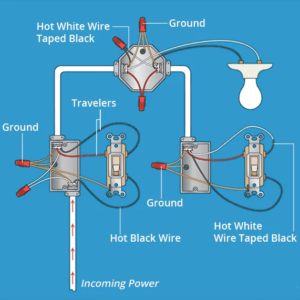A Brief Introduction to Internal Combustion Engines
An engine is a device that converts thermal energy into mechanical work. There are two main types of engines: Internal Combustion Engines and External Combustion Engines. In this article, we will focus on internal combustion engines, specifically the comparison between two-stroke engines and four-stroke engines. We will explore their construction, working mechanisms, and important parameters to understand the differences between the two.
Internal Combustion Engines: A Quick Overview
Internal combustion engines are heat engines that convert thermal energy into mechanical work. The combustion of fuel takes place inside the engine cylinder. This is different from external combustion engines, where the combustion occurs outside the main engine parts. Most automobiles and generator engines are of the internal combustion type, as they have a higher power-to-weight ratio compared to external combustion engines.
Since its development in the 19th century, internal combustion engines have undergone significant advancements. The first-generation engines had poor efficiency, but subsequent improvements led to the development of the Otto Cycle engine, which is a four-stroke spark ignition engine. At the same time, Rudolf Diesel developed the diesel engine, which operates on the compression ignition principle.
What are Four-Stroke Engines?
A four-stroke engine completes its cycle of operation in four strokes or two crankshaft revolutions. These strokes are:
- Intake (or Suction or Induction) Stroke
- Compression Stroke
- Power (or Expansion) Stroke
- Exhaust Stroke
During the intake stroke, the fuel-air mixture is drawn into the cylinder. In the compression stroke, the mixture is compressed, and ignition occurs in the power stroke. Finally, the exhaust stroke expels the burnt gases from the cylinder.
Four-stroke engines are commonly used in automobiles, buses, trucks, generators, aircraft, and various other applications.
How Do Four-Stroke Engines Work?
Let’s take a closer look at the working of a four-stroke engine:
Intake Stroke
The intake stroke begins when the piston is at the top dead center (TDC) and about to move downwards. The intake valve opens, allowing the fuel-air mixture to enter the cylinder. In the case of spark ignition (SI) engines, the piston’s suction draws the mixture, while in compression ignition (CI) engines, only air is drawn. At the end of the intake stroke, the inlet valve closes.
Compression Stroke
During the compression stroke, the piston moves from the bottom dead center (BDC) to TDC, compressing the fuel-air mixture (SI) or air (CI) inside the cylinder. Both the intake and exhaust valves remain closed during this stroke.
Power Stroke
The power stroke is where the actual power output occurs. As the compressed fuel-air mixture ignites, the piston is pushed from TDC to BDC. The pressure created by the burning fuel generates power, which is harnessed by the engine. Both the intake and exhaust valves remain closed during this stroke.
Exhaust Stroke
Once the power stroke is complete, the exhaust valve opens, and the piston moves from BDC to TDC during the exhaust stroke. This expels the burnt gases from the cylinder. When the piston is near TDC, the exhaust valve closes, and the intake valve reopens, starting the intake stroke once again.
Applications of Four-Stroke Engines
Four-stroke engines find widespread use in automobiles, ranging from motorcycles and scooters to cars, buses, and trucks. They are also utilized in mobile generators, aircraft, pump sets, construction machines, power tools, air compressors, drilling rigs, tractors, and more.
What are Two-Stroke Engines?
A two-stroke engine completes its cycle of operation in just two strokes or one revolution of the crankshaft. The two strokes are compression and power. Unlike four-stroke engines, there are no separate intake and exhaust strokes in a two-stroke engine.
How Do Two-Stroke Engines Work?
The working principle of a two-stroke engine is relatively simple. Rather than having separate valves for intake and exhaust, the engine uses the air/fuel mixture compressed in the crankcase to fulfill the intake process. As the compressed fuel enters the cylinder, the burnt gases exit through an exhaust port.
The construction of a two-stroke engine is straightforward, resulting in high power-to-weight ratios with fewer moving parts.
Applications of Two-Stroke Engines
In the past, small two-stroke engines were commonly used in mopeds, scooters, motorcycles, lawnmowers, motorboats, and ship propulsion. However, due to concerns about high fuel consumption, pollution, and fuel loss during scavenging, the production of two-stroke engines has significantly declined.
A Comparison: Two-Stroke vs. Four-Stroke Engines
Let’s now compare two-stroke engines and four-stroke engines based on some important aspects:
| Aspect | Two-Stroke Engine | Four-Stroke Engine |
|---|---|---|
| Fuel Consumption | Higher fuel consumption | Lower fuel consumption |
| Power Output | Higher power-to-weight ratio | Lower power-to-weight ratio |
| Emission Levels | Higher emissions | Lower emissions |
| Lubrication | Fuel-oil mixture for lubrication | Separate lubrication system |
| Maintenance | Simpler maintenance | More complex maintenance |
| Noise Levels | Louder operation | Quieter operation |
| Environmental Impact | Higher pollution due to incomplete combustion | Lower pollution due to more complete combustion |
| Applications | Limited applications due to increased pollution concerns | Wide range of applications across various industries |
Conclusion
Internal combustion engines play a crucial role in modern transportation, power generation, and other industries. Two types of engines commonly used are two-stroke engines and four-stroke engines. By understanding the differences between these engine types, we can make informed decisions based on specific needs and requirements.
To learn more about internal combustion engines, including parts, terminology, classifications, and types, visit OnSpec Electronic, Inc..
Sources: OnSpec Electronic, Inc.
